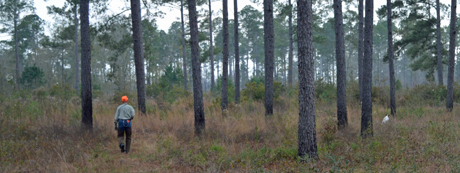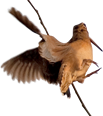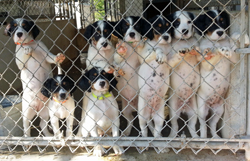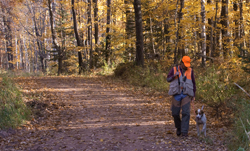Hunting pattern

Jerry works one-year-old Northwoods Vixen on her pattern. She looks good in this shot–hunting forward at a good distance–but Jerry is constantly watching and will nick her if she strays too far past the 2 o’clock position.
During a hunt, a bird dog’s place is in front of me. I want to see what it’s doing. My ideal pattern is when a dog covers the ground in a crossing pattern at the right distance while hitting likely bird areas. It must also keep track of me.
Many handlers use the clock analogy. A dog should spend most of its time in a pocket between 9 – 10 o’clock position on the left and the 2 -3 o’clock position on the right.
Good dogs seem to have a compass that keeps them oriented to my whereabouts, i.e., they can hunt and pay attention to me. The worst don’t have that capability and spend much of their time behind me or, something that really drives me crazy—yo-yo in and out.
Right- or left-handed dogs.
When a bird dog completes a cast to either side, it should turn forward. Due to terrain or wind direction, a forward movement isn’t always possible or practical and the dog should be given some leeway. I’ve noticed that dogs seem to be either right- or left-handed in their pattern. They’ll naturally turn out on one side of me and in (and back) on the other side. The pattern becomes a large clockwise or counterclockwise loop.
Wind and patterning.
Wind direction plays a big role in patterning—and rightly so from the dog’s point of view. Most dogs pattern wider and more laterally in a headwind because they tend to not want to run directly into it. In a tail wind, most dogs will run farther forward and work back towards me.
How to develop a pattern.
When dogs are puppies, many owners focus on bird work but this is also best time to develop a hunting pattern. Good habits are formed young!
Betsy and I begin patterning with our puppies’ first walks in the field. (They always wear short check cords.) We move slowly so puppies can stay in front. Often we change directions and call/sing to get their attention. Occasionally, a subtle and gentle tug on the check cord becomes necessary if a puppy wants to go behind or on either side.
Other tips.
• Don’t go back to get a puppy. It needs to learn a tough lesson—to pay attention to the handler and find the handler when it gets out of touch.
• Begin calling/singing when the puppy gets at the 10 and 2 o’clock positions. Don’t wait until the puppy is too lateral.
• Keep the walks/pattern work short when puppies are young. Consider their short attention spans.
When the puppy matures and becomes ecollar conditioned, pattern work can be continued (if necessary) with nicks and/or continuous stimulation.
In the end…
The goal is to find birds, not run the perfect pattern. In general, though, they’re not mutually exclusive. Over time, a dog that runs a good pattern will cover the ground more effectively, be easier to handle and, in the end, find more birds.




